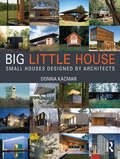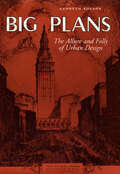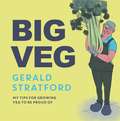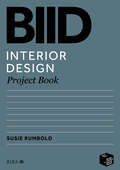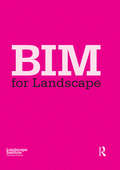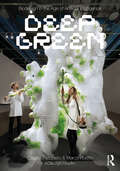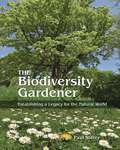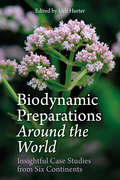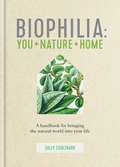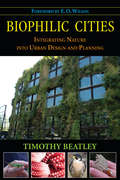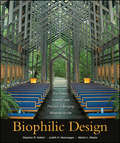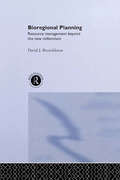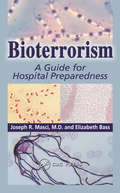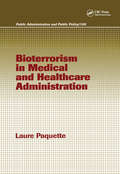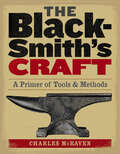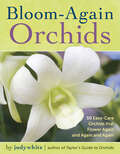- Table View
- List View
BIG little house: Small Houses Designed by Architects
by Donna KacmarWhat are the challenges architects face when designing dwelling spaces of a limited size? And what can these projects tell us about architecture – and architectural principles – in general? In BIG little house, award-winning architect Donna Kacmar introduces twenty real-life examples of small houses. Each project is under 1,000 square feet (100 square meters) in size and, brought together, the designs reveal an attitude towards materiality, light, enclosure and accommodation which is unique to minimal dwellings. While part of a trend to address growing concerns about minimising consumption and lack of affordable housing, the book demonstrates that small dwellings are not always simply the result of budget constraints but constitute a deliberate design strategy in their own right. Highly illustrated and in full-colour throughout, each example is based on interviews with the original architect and accompanied by detailed floor plans. This ground-breaking, beautifully designed text offers practical guidance to any professional architect or homeowner interested in small scale projects.
Big Plans: The Allure and Folly of Urban Design (Center Books on Contemporary Landscape Design)
by Kenneth KolsonBig Plans: The Allure and Folly of Urban Design springs from the idea that human aspirations for the city tend to overstate the role of rationality in public life. Inspired by the architectural and urban criticism of such writers as Lewis Mumford, Jane Jacobs, and John Brinckerhoff Jackson, Kolson adopts a user's perspective on issues of urban design, an approach that highlights both the futility of social engineering and the resilience of the human spirit.
Big Veg: Learn how to grow-your-own with 'The Vegetable King'
by Gerald StratfordLearn how to grow big veg with Gerald Stratford, the gardening grandad loved by over a quarter of a million fans on Twitter. "I am very grateful for all the interest my wonderful friends and followers have taken in my gardening. Now, I hope this book gives you the motivation you need to get out in the garden. Cheers!" - GERALDGerald's book is packed with decades of gardening know-how and fully illustrated with photos from his Cotswolds garden. It includes a helpful month-by-month guide to sowing, planting and harvesting veg, as well as tips on how to grow Gerald's speciality: really big veg. Full of encouragement and Gerald's infectious enthusiasm, Big Veg makes an ideal companion for anyone keen to grow-your-own.
BIID Interior Design Project Book
by Susie RumboldThe touchstone guide to running projects from the British Institute of Interior Design (BIID). By setting out actions step-by-step, this essential handbook identifies the key obligations of the interior designer at each project stage. Straightforward explanation is supplemented by invaluable checklists and templates. Featuring crucial advice on administering construction contracts, it references the new RIBA/BIID Domestic Professional Services Contract 2020 for interior design services. Reflecting the RIBA Plan of Work 2020 and contemporary working practice, it provides a systematic operational framework that can be applied to all types of projects. Comprehensive in scope with a logical structure, it embraces the theme of collaboration within the project team. It also addresses post-occupancy evaluation, modern methods of construction and sustainability. Suitable for projects within any industry sector and practice type, from large international firms to sole practitioners, it is accessible to designers with different levels of experience.
BIID Interior Design Project Book
by Susie RumboldThe touchstone guide to running projects from the British Institute of Interior Design (BIID). By setting out actions step-by-step, this essential handbook identifies the key obligations of the interior designer at each project stage. Straightforward explanation is supplemented by invaluable checklists and templates. Featuring crucial advice on administering construction contracts, it references the new RIBA/BIID Domestic Professional Services Contract 2020 for interior design services. Reflecting the RIBA Plan of Work 2020 and contemporary working practice, it provides a systematic operational framework that can be applied to all types of projects. Comprehensive in scope with a logical structure, it embraces the theme of collaboration within the project team. It also addresses post-occupancy evaluation, modern methods of construction and sustainability. Suitable for projects within any industry sector and practice type, from large international firms to sole practitioners, it is accessible to designers with different levels of experience.
Bike Share
by Elliot FishmanThere are now over 2,000 cities with a bike share program. Bike Share examines all the major developments in the 50-year history of bike share. The book provides a detailed focus on contemporary bike share programs, including many of the most prominent systems, such as those in Paris, London, and New York, as well as the rapidly emerging dockless bike share sector. This book also addresses how rapid technological innovation, particularly in terms of mobile internet devices and electric assist bicycles may change the face of not just cycling, but urban mobility more generally. By the end of 2018 it was estimated that there are more than 20 million bicycles in the global bike share fleet, with most of these dockless, coming online only in the last three years. Consequently, research examining bike share has not kept pace with the rapid deployment of this new form of urban mobility. Bike Share addresses a number of key themes such as: The urban age, contextualising bike share within a wider urbanism movement and how it sits within the growing sharing economy. The impact of bike share, looking at systems in China, Europe, North America and Australia to see how these programs have changed travel patterns and consequent impact on car use, emissions, congestion, public health and safety. The bike share business model, including how ride sourcing services like Uber and Lyft are beginning to integrate their business with bike share service providers. Public reaction to bike share. Bike share gone wrong, looking at systems that have failed to achieve their ridership estimates. And the future of bike share including public transport smart card integration, mobile payments, and electric assist bicycles. The book provides scholars, city planners, transportation practitioners and students with a resource that captures the most pertinent scientific findings and practical lessons that have been from bike share programs around the world.
Bike Share
by Elliot FishmanThere are now over 2,000 cities with a bike share program. Bike Share examines all the major developments in the 50-year history of bike share. The book provides a detailed focus on contemporary bike share programs, including many of the most prominent systems, such as those in Paris, London, and New York, as well as the rapidly emerging dockless bike share sector. This book also addresses how rapid technological innovation, particularly in terms of mobile internet devices and electric assist bicycles may change the face of not just cycling, but urban mobility more generally. By the end of 2018 it was estimated that there are more than 20 million bicycles in the global bike share fleet, with most of these dockless, coming online only in the last three years. Consequently, research examining bike share has not kept pace with the rapid deployment of this new form of urban mobility. Bike Share addresses a number of key themes such as: The urban age, contextualising bike share within a wider urbanism movement and how it sits within the growing sharing economy. The impact of bike share, looking at systems in China, Europe, North America and Australia to see how these programs have changed travel patterns and consequent impact on car use, emissions, congestion, public health and safety. The bike share business model, including how ride sourcing services like Uber and Lyft are beginning to integrate their business with bike share service providers. Public reaction to bike share. Bike share gone wrong, looking at systems that have failed to achieve their ridership estimates. And the future of bike share including public transport smart card integration, mobile payments, and electric assist bicycles. The book provides scholars, city planners, transportation practitioners and students with a resource that captures the most pertinent scientific findings and practical lessons that have been from bike share programs around the world.
BIM for Landscape
by Landscape InstituteBIM (Building Information Modelling) is transforming working practices across the built environment sector, as clients, professionals, contractors and manufacturers throughout the supply chain grasp the opportunities that BIM presents. The first book ever to focus on the implementation of BIM processes in landscape and external works, BIM for Landscape will help landscape professionals understand what BIM means for them. This book is intended to equip landscape practitioners and practices to meet the challenges and reap the rewards of working in a BIM environment - and to help professionals in related fields to understand how BIM processes can be brought into landscape projects. BIM offers significant benefits to the landscape profession, and heralds a new chapter in inter-disciplinary relationships. BIM for Landscape shows how BIM can enhance collaboration with other professionals and clients, streamline information processes, improve decision-making and deliver well-designed landscape projects that are right first time, on schedule and on budget. This book looks at the organisational, technological and professional practice implications of BIM adoption. It discusses in detail the standards, structures and information processes that form BIM Level 2-compliant workflows, highlighting the role of the landscape professional within the new ways of working that BIM entails. It also looks in depth at the digital tools used in BIM projects, emphasising the ‘information’ in Building Information Modelling, and the possibilities that data-rich models offer in landscape design, maintenance and management. BIM for Landscape will be an essential companion to the landscape professional at any stage of their BIM journey.
BIM for Landscape
by Landscape InstituteBIM (Building Information Modelling) is transforming working practices across the built environment sector, as clients, professionals, contractors and manufacturers throughout the supply chain grasp the opportunities that BIM presents. The first book ever to focus on the implementation of BIM processes in landscape and external works, BIM for Landscape will help landscape professionals understand what BIM means for them. This book is intended to equip landscape practitioners and practices to meet the challenges and reap the rewards of working in a BIM environment - and to help professionals in related fields to understand how BIM processes can be brought into landscape projects. BIM offers significant benefits to the landscape profession, and heralds a new chapter in inter-disciplinary relationships. BIM for Landscape shows how BIM can enhance collaboration with other professionals and clients, streamline information processes, improve decision-making and deliver well-designed landscape projects that are right first time, on schedule and on budget. This book looks at the organisational, technological and professional practice implications of BIM adoption. It discusses in detail the standards, structures and information processes that form BIM Level 2-compliant workflows, highlighting the role of the landscape professional within the new ways of working that BIM entails. It also looks in depth at the digital tools used in BIM projects, emphasising the ‘information’ in Building Information Modelling, and the possibilities that data-rich models offer in landscape design, maintenance and management. BIM for Landscape will be an essential companion to the landscape professional at any stage of their BIM journey.
Biodesign in the Age of Artificial Intelligence: Deep Green
by Claudia Pasquero Marco PolettoBiodesign in the Age of Artificial Intelligence: Deep Green investigates the potential of nature-based technology for shaping the evolution of contemporary architecture and design. It takes on the now pervasive topic of design intelligence, extending its definition to encompass both biological and digital realms. As in their first title, Systemic Architecture: Operating Manual for the Self-Organizing City, the authors engage the topic through the specific lens of their innovative design practice, ecoLogicStudio, and their research at the University of Innsbruck and at the Bartlett, UCL. Part One of the book, entitled PhotoSynthetica™, illustrates design solutions that engage the urban microbiome and seek to achieve an immediate impact, while Part Two, entitled Deep Green, includes synthetic landscapes and operates within a much larger spatio-temporal frame, going beyond human perception and life span to envision design as a geographical and geological force. In the age of catastrophic climate change, such perceptual expansion helps to clarify that change cannot simply be stopped or rolled back. We must instead establish more positive dynamics of change within the living world. To this end, this book proposes to engage with design and architecture as an extended cognitive interface, a sentient being that is co-evolutionary and symbiotic with the living planet, contributing to its beauty and to our continued enjoyment of it.
Biodesign in the Age of Artificial Intelligence: Deep Green
by Claudia Pasquero Marco PolettoBiodesign in the Age of Artificial Intelligence: Deep Green investigates the potential of nature-based technology for shaping the evolution of contemporary architecture and design. It takes on the now pervasive topic of design intelligence, extending its definition to encompass both biological and digital realms. As in their first title, Systemic Architecture: Operating Manual for the Self-Organizing City, the authors engage the topic through the specific lens of their innovative design practice, ecoLogicStudio, and their research at the University of Innsbruck and at the Bartlett, UCL. Part One of the book, entitled PhotoSynthetica™, illustrates design solutions that engage the urban microbiome and seek to achieve an immediate impact, while Part Two, entitled Deep Green, includes synthetic landscapes and operates within a much larger spatio-temporal frame, going beyond human perception and life span to envision design as a geographical and geological force. In the age of catastrophic climate change, such perceptual expansion helps to clarify that change cannot simply be stopped or rolled back. We must instead establish more positive dynamics of change within the living world. To this end, this book proposes to engage with design and architecture as an extended cognitive interface, a sentient being that is co-evolutionary and symbiotic with the living planet, contributing to its beauty and to our continued enjoyment of it.
The Biodiversity Gardener: Establishing a Legacy for the Natural World (Wild Nature Press #34)
by Paul SterryA personal account of—and guide to—unlocking the wildlife potential of gardens and other plots of land in lowland BritainOver the past decade, wildlife author and photographer Paul Sterry has nurtured, both through action and by doing nothing, what has become a small island of flourishing biodiversity in the half-acre garden that surrounds his north Hampshire cottage. By giving nature a free hand, and fostering habitats appropriate to this part of southeast England, he has enabled an abundance of native plant and animal species to call the garden home. This contrasts with the continued decline in biodiversity in the surrounding countryside. In this inspiring and informative book, Sterry tells the story of his own experiences in biodiversity gardening and offers detailed practical advice to anyone who wants to give nature the upper hand on their own bit of land, no matter how small.Hampshire still retains traces of its rich wildlife heritage, but changes in land use over the past half-century have had a devastating impact on local biodiversity. Against this backdrop, The Biodiversity Gardener presents a habitat-driven and evidence-based approach, describing how any gardener can unlock the wildlife potential of their plot and enjoy the satisfaction of watching it become home to a rich array of native species, including butterflies, wildflowers, grasshoppers, amphibians, and fungi.In The Biodiversity Gardener, Sterry explains the ecological imperative of adopting this approach. Collectively, biodiversity gardens could leave a lasting legacy—wildlife oases from which future generations stand a fighting chance of restoring Britain’s natural heritage. The book encourages and empowers readers to create their own biological inheritance for posterity—and shows them how they can do it.
Biodynamic Preparations Around the World: Insightful Case Studies from Six Continents
by Ueli HurterBiodynamic agriculture first originated in central Europe but is now practised in farms, vineyards and gardens all over the world. At the heart of the biodynamic approach are the eight preparations – Horn manure, Horn silica, Yarrow, Chamomile, Nettle, Oak bark, Dandelion and Valerian – which are often produced by local biodynamic practitioners using well-established recipes. But as the biodynamic approach expands beyond its European origins, its methods have been increasingly adapted to meet the needs and challenges – climates, fauna, seasons and regulations – of different regions around the globe. This fascinating book presents the results of a unique study, carried out by the Agricultural Section at the Goetheanum, Switzerland, into how the biodynamic preparations are used in fifteen countries worldwide, including Egypt, Brazil, New Zealand, India and across Europe. The detailed case studies explore how the preparations are modified to suit their locations, as well as offering an insight into the work of each practitioner and how their understanding has evolved over the years.This book is a valuable reference into the production and application of the preparations around the world and an inspiring endorsement of how biodynamic principles hold true in such varied environments.
Biophilia: You + Nature + Home
by Sally CoulthardIn this beautifully illustrated guide, best-selling author Sally Coulthard demonstrates how to transform your living and working spaces into places that put you in touch with nature.Eight inspiring chapters cover key elements for the 'biophilic home', including materials, views, colour and natural light. Each section explores the links between home, health and happiness, drawing on environmental research and neuroscience while making practical suggestions for bringing the natural world into your home.Bring nature indoors with flowers and plants, rediscover the innate pleasure of real fires and fresh air, and learn how to improve your mood and sleep patterns with dynamic light. Create a space filled with natural elements, patterns, nature's colours, fabrics and textures that lift your mood; find out why natural sounds and water are soothing; and learn how to make small changes that will inspire, invigorate and enrich your relationship with the natural world.
Biophilic Cities: Integrating Nature into Urban Design and Planning (Cities And The Global Politics Of The Environment Ser.)
by Timothy BeatleyTim Beatley has long been a leader in advocating for the "greening" of cities. But too often, he notes, urban greening efforts focus on everything except nature, emphasizing such elements as public transit, renewable energy production, and energy efficient building systems. While these are important aspects of reimagining urban living, they are not enough, says Beatley. We must remember that human beings have an innate need to connect with the natural world- (the biophilia hypothesis). And any vision of a sustainable urban future must place its focus squarely on nature, on the presence, conservation, and celebration of the actual green features and natural life forms. A biophilic city is more than simply a biodiverse city, says Beatley. It is a place that learns from nature and emulates natural systems, incorporates natural forms and images into its buildings and cityscapes, and designs and plans in conjunction with nature. A biophilic city cherishes the natural features that already exist but also works to restore and repair what has been lost or degraded. In Biophilic Cities Beatley not only outlines the essential elements of a biophilic city, but provides examples and stories about cities that have successfully integrated biophilic elements--from the building to the regional level--around the world.
Biophilic Design: The Theory, Science and Practice of Bringing Buildings to Life
by Stephen R. Kellert Judith Heerwagen Martin Mador"When nature inspires our architecture-not just how it looks but how buildings and communities actually function-we will have made great strides as a society. Biophilic Design provides us with tremendous insight into the 'why,' then builds us a road map for what is sure to be the next great design journey of our times." -Rick Fedrizzi, President, CEO and Founding Chairman, U.S. Green Building Council "Having seen firsthand in my company the power of biomimicry to stimulate a wellspring of profitable innovation, I can say unequivocably that biophilic design is the real deal. Kellert, Heerwagen, and Mador have compiled the wisdom of world-renowned experts to produce this exquisite book; it is must reading for scientists, philosophers, engineers, architects and designers, and-most especially-businesspeople. Anyone looking for the key to a new type of prosperity that respects the earth should start here." -Ray C. Anderson, founder and Chair, Interface, Inc. The groundbreaking guide to the emerging practice of biophilic design This book offers a paradigm shift in how we design and build our buildings and our communities, one that recognizes that the positive experience of natural systems and processes in our buildings and constructed landscapes is critical to human health, performance, and well-being. Biophilic design is about humanity's place in nature and the natural world's place in human society, where mutuality, respect, and enriching relationships can and should exist at all levels and should emerge as the norm rather than the exception. Written for architects, landscape architects, planners,developers, environmental designers, as well as building owners, Biophilic Design: The Theory, Science, and Practice of Bringing Buildings to Life is a guide to the theory, science, and practice of biophilic design. Twenty-three original and timely essays by world-renowned scientists, designers, and practitioners, including Edward O. Wilson, Howard Frumkin, David Orr, Grant Hildebrand, Stephen Kieran, Tim Beatley, Jonathan Rose, Janine Benyus, Roger Ulrich, Bert Gregory, Robert Berkebile, William Browning, and Vivian Loftness, among others, address: * The basic concepts of biophilia, its expression in the built environment, and how biophilic design connects to human biology, evolution, and development. * The science and benefits of biophilic design on human health, childhood development, healthcare, and more. * The practice of biophilic design-how to implement biophilic design strategies to create buildings that connect people with nature and provide comfortable and productive places for people, in which they can live, work, and study. Biophilic design at any scale-from buildings to cities-begins with a few simple questions: How does the built environment affect the natural environment? How will nature affect human experience and aspiration? Most of all, how can we achieve sustained and reciprocal benefits between the two? This prescient, groundbreaking book provides the answers.
Biophilic Design: The Theory, Science and Practice of Bringing Buildings to Life
by Stephen R. Kellert Judith Heerwagen Martin Mador"When nature inspires our architecture-not just how it looks but how buildings and communities actually function-we will have made great strides as a society. Biophilic Design provides us with tremendous insight into the 'why,' then builds us a road map for what is sure to be the next great design journey of our times." -Rick Fedrizzi, President, CEO and Founding Chairman, U.S. Green Building Council "Having seen firsthand in my company the power of biomimicry to stimulate a wellspring of profitable innovation, I can say unequivocably that biophilic design is the real deal. Kellert, Heerwagen, and Mador have compiled the wisdom of world-renowned experts to produce this exquisite book; it is must reading for scientists, philosophers, engineers, architects and designers, and-most especially-businesspeople. Anyone looking for the key to a new type of prosperity that respects the earth should start here." -Ray C. Anderson, founder and Chair, Interface, Inc. The groundbreaking guide to the emerging practice of biophilic design This book offers a paradigm shift in how we design and build our buildings and our communities, one that recognizes that the positive experience of natural systems and processes in our buildings and constructed landscapes is critical to human health, performance, and well-being. Biophilic design is about humanity's place in nature and the natural world's place in human society, where mutuality, respect, and enriching relationships can and should exist at all levels and should emerge as the norm rather than the exception. Written for architects, landscape architects, planners,developers, environmental designers, as well as building owners, Biophilic Design: The Theory, Science, and Practice of Bringing Buildings to Life is a guide to the theory, science, and practice of biophilic design. Twenty-three original and timely essays by world-renowned scientists, designers, and practitioners, including Edward O. Wilson, Howard Frumkin, David Orr, Grant Hildebrand, Stephen Kieran, Tim Beatley, Jonathan Rose, Janine Benyus, Roger Ulrich, Bert Gregory, Robert Berkebile, William Browning, and Vivian Loftness, among others, address: * The basic concepts of biophilia, its expression in the built environment, and how biophilic design connects to human biology, evolution, and development. * The science and benefits of biophilic design on human health, childhood development, healthcare, and more. * The practice of biophilic design-how to implement biophilic design strategies to create buildings that connect people with nature and provide comfortable and productive places for people, in which they can live, work, and study. Biophilic design at any scale-from buildings to cities-begins with a few simple questions: How does the built environment affect the natural environment? How will nature affect human experience and aspiration? Most of all, how can we achieve sustained and reciprocal benefits between the two? This prescient, groundbreaking book provides the answers.
Bioregional Planning: Resource Management Beyond the New Millennium
by D J BrunckhorstPresenting a pragmatic mixture of science, landscape ecology, ecosystem management, sociology, policy development and methods for transforming social and institutional cultures. Bioregional Planning: Resource Management Beyond the New Millennium is a timely and practical guide for the analysis, planning and development of bioregional projects for a sustainable future. Significantly, this book presents the strategic actions necessary to plan for, manage and adapt to Ecologically Sustainable Development with a view beyond the new millennium and towards the next. Postgraduates, researchers and policy makers in natural resources management, land planning, sustainable agriculture, rural sciences, ecosystem management and conservation biology will find this book captures the essence of bioregional planning succinctly and makes a compelling argument for why it is a key mechanism in the development of effective governance institutions.
Bioregional Planning: Resource Management Beyond the New Millennium
by D J BrunckhorstPresenting a pragmatic mixture of science, landscape ecology, ecosystem management, sociology, policy development and methods for transforming social and institutional cultures. Bioregional Planning: Resource Management Beyond the New Millennium is a timely and practical guide for the analysis, planning and development of bioregional projects for a sustainable future. Significantly, this book presents the strategic actions necessary to plan for, manage and adapt to Ecologically Sustainable Development with a view beyond the new millennium and towards the next. Postgraduates, researchers and policy makers in natural resources management, land planning, sustainable agriculture, rural sciences, ecosystem management and conservation biology will find this book captures the essence of bioregional planning succinctly and makes a compelling argument for why it is a key mechanism in the development of effective governance institutions.
Bioterrorism: A Guide for Hospital Preparedness
by Joseph R. Masci M.D. Elizabeth BassIn the battle against bioterrorism, one of the greatest challenges is finding the ideal balance between complacency and overreaction. The goal is to be so well prepared that we can prevent catastrophic outcomes in the event of a bioterrorist attack, while strengthening our ability to prevent and treat naturally-occurring infectious diseases.Bioterr
Bioterrorism: A Guide for Hospital Preparedness
by Joseph R. Masci M.D. Elizabeth BassIn the battle against bioterrorism, one of the greatest challenges is finding the ideal balance between complacency and overreaction. The goal is to be so well prepared that we can prevent catastrophic outcomes in the event of a bioterrorist attack, while strengthening our ability to prevent and treat naturally-occurring infectious diseases.Bioterr
Bioterrorism in Medical and Healthcare Administration
by Laure PaquetteBioterrorism in Medical and Healthcare Administration provides an efficient method to identify, manage, and control transformations in the provision of health services during elevated levels of bioterrorist threat - offering step-by-step procedures and templates to prepare and implement a coordinated response to high-alert situations. This reference proposes an efficient method to identify, manage, and control transformations in the provision of health services during elevated levels of bioterrorist threat - offering step-by-step procedures and templates to prepare and implement a coordinated response to high-alert situations.
Birkenhead Park: The People's Garden and an English Masterpiece
by Robert LeeWhen it was officially opened on Easter Monday, 5th April 1847, Birkenhead park became the first municipally funded park in Britain. It was a pioneer in the development of urban public parks, designed for use by everyone, irrespective of social class, ethnicity or age. In terms of town planning, it demonstrated the importance of including green infrastructure in urban development as a vital contribution to public health and wellbeing. Paxton’s design for the park was heralded as ‘a masterpiece of human creative genius’ : it served as a vehicle for the global transmission of the English landscape school and led to the creation of numerous public parks everywhere, most famously Central Park, New York, incorporating of many of Paxton’s design features. This book addresses a long-standing gap in the Park’s historiography. Regarded as ‘one of the greatest wonders of the age’, it is an important contribution to nineteenth-century landscape history with a local focus, but of international significance. But it seeks to interpret the Park’s development until 1914 within a political and cultural context, drawing on economic and social history, as a means of explaining why it was not until the late-nineteenth century that it finally became a focal point for recreation and public health.
The Blacksmith's Craft: A Primer of Tools & Methods
by Charles McRavenCharles McRaven guides you through the process of building a forge from recycled materials, acquiring tools, and learning basic blacksmithing techniques.
Bloom-Again Orchids: 50 Easy-Care Orchids that Flower Again and Again and Again
by judywhiteIf you've always been intrigued by orchids but were nervous about caring for them, put your worries aside. Bloom-Again Orchids will turn you from a would-be orchid fan into the proud owner of healthy plants that will bloom year after year.
